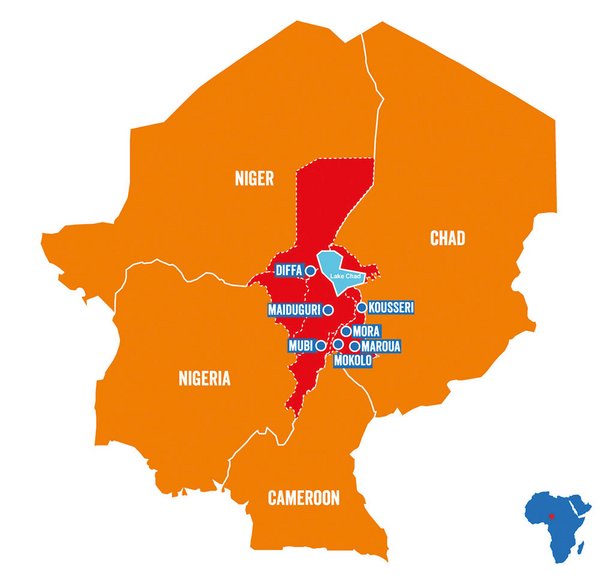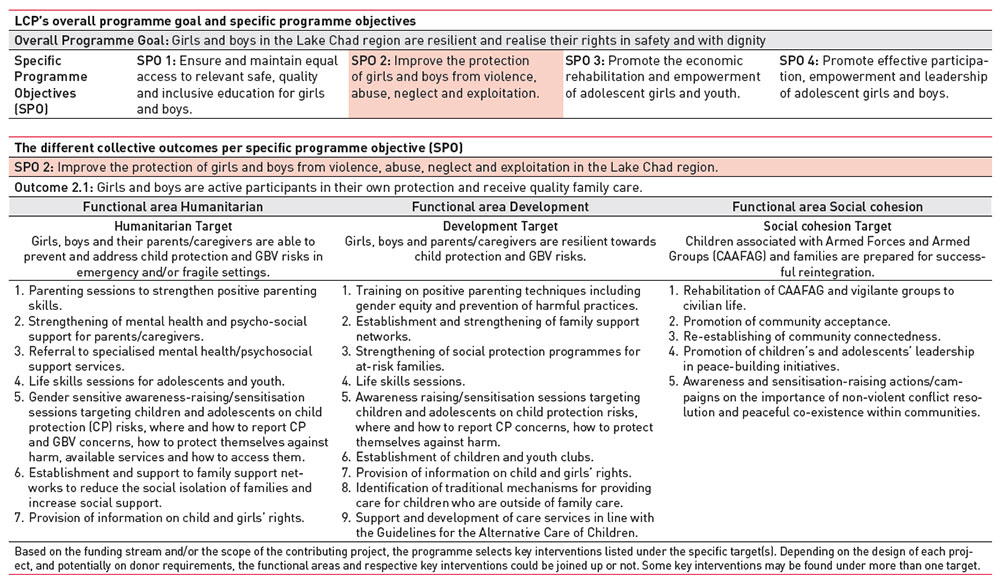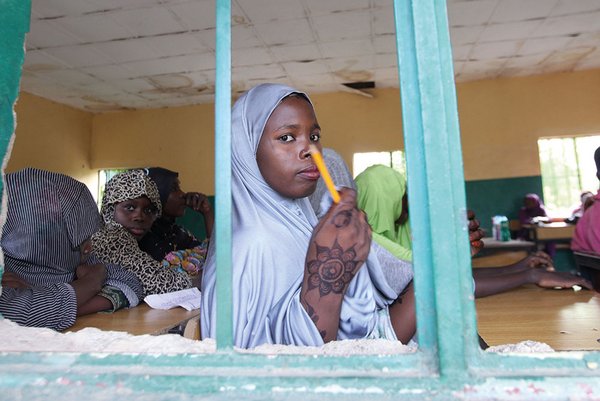 Download this article in magazine layout
Download this article in magazine layout
- Share this article
- Subscribe to our newsletter
Promoting children's rights and gender equity
The protracted crisis in the Lake Chad Basin (LCB) region remains one of the most severe humanitarian emergencies in the world, affecting the North East of Nigeria, the Far North region of Cameroon, the Lake region of Chad and the Diffa region in Niger (see Map). More than 17 million people are living in the affected areas across the four countries. A total of 10.7 million people are in need of humanitarian assistance to survive, more than six million of them are children. The current humanitarian crisis escalated in 2014 due to violence of insurgent groups, notably Boko Haram, and ensuing conflict, resulting in the internal displacement of more than 2.5 million people in Nigeria, Cameroon, Niger, and Chad, as well as – according to latest figures of the UN Refugee Agency UNHCR – over 270,000 refugees from Nigeria seeking refuge in the neighbouring countries. However, the roots of the crisis are more longstanding and pernicious in a region beset by chronic fragility where poverty, underdevelopment, gender inequality, unemployment and a lack of prospects for young people fuel extremism. This is compounded by environmental degradation and the impact of climate change.
From a humanitarian response to a nexus approach

The Lake Chad Programme (LCP) is a joint initiative of Plan International’s Country Offices in Cameroon, Niger, and Nigeria as well as the organisation’s West and Central Africa Hub. It was established to address the crisis in the LCB through an integrated and regional programme approach. Although the response to the crisis started in Cameroon and Niger in 2014, the joint programme vision for the LCP was developed in May 2016. This resulted in the first Regional Programmatic Response Strategy and included the purely humanitarian response activities in the affected areas. It was the first time that Plan International was piloting a multi-country, multi-sector, and multi-donor programme approach of this scale to address one single crisis through a co-ordinated programme approach. To date, more than 40 projects are contributing to the programme, covering the areas of education in emergencies, child protection in emergencies, gender-based violence (GBV) and livelihoods/youth economic empowerment.
The second phase of the programme (2018-2023) moves beyond a humanitarian vision towards a full spectrum programme, working at the nexus of humanitarian, development and peace-building efforts to promote children’s rights and gender equality in the region. Four specific programme objectives (see Box) were elaborated. They comprise collective (nexus) outcomes across the humanitarian, development, and social cohesion functional areas, thus allowing the LCP to respond holistically to the humanitarian needs of the affected population while simultaneously tackling the developmental deficit of the region, which is both a root cause and an outcome of the crisis. In addition, promoting social cohesion and resilience, as well as transforming gender norms by removing the barriers that keep girls from achieving their full potential and exercising their rights, are central issues in the region and are at the heart of the strategy. Moreover, building the resilience of girls and their communities is vital to ensure they are able to cope with, and adapt to, the significant shocks and stresses they face currently and, possibly, in future.
The full spectrum approach in practice
The starting point for enhancing the strategy was a joint context analysis between Plan International’s humanitarian and development teams in the LCB, which allowed them to identify the humanitarian needs, but also the root causes and structural drivers of the crisis. This analysis resulted in the formulation of collective outcomes, based on the understanding that communities have humanitarian, development and social needs simultaneously. However most of the time one of them is predominant and therefore requires that the respective functional area takes the lead in terms of programming.
Taking into account that the LCB crisis is first and foremost a regional protection crisis, it is worth illustrating the complementarity of the interventions, using the sectors of child protection and GBV. The collective programme objective is to “improve the protection of girls and boys from violence, abuse, neglect, and exploitation in the Lake Chad region”, which comes with three related outcomes focusing on girls and boys as active participants in their own protection, establishing and strengthening of community-based and government-led child protection systems and ensuring access to appropriate and timely services to prevent and respond to child protection and GBV issues respectively.
For of the outcomes mentioned, there is a set of key interventions per functional area which are being implemented simultaneously but with different intensity, setting out from the area-based approach and the predominant needs prevailing in the respective community.
For instance, a common humanitarian intervention would be the development of referral pathways for child protection and GBV cases and the provision of tailored case management services, while a development activity could focus on addressing socio-cultural norms that condone violence against children and GBV (including engaging with girls’ and women’s rights organisations for resilience building) as well as capacity building of government social workers and local community-based organisations to manage and respond to protection cases and to support the government in strengthening the child protection and GBV information management system (advocacy and system strengthening). At the same time, a social cohesion activity would focus on community engagement to prevent the stigmatisation of GBV and child survivors, the reintegration of children associated with armed forces and armed groups, and the promotion of their social inclusion (see Box below). It is important to highlight that funding streams are kept separate, i.e. humanitarian funding is only used for humanitarian activities, while development and social cohesion interventions are funded through additional working streams focusing on development and crisis prevention/stabilisation.

Integration in the national and international aid structure
The full spectrum programme structure provides Plan and its partners and donors with a framework of collaboration allowing each of them to work according to their own core mandate. Instead of mixing humanitarian and development projects with their different objectives and guiding principles, the co-ordinated programme approach with collective outcomes for each programmatic sector enables the LCP to continue the implementation of straightforward and immediate lifesaving projects, while at the same time engaging with longer-term sustainable development projects to enhance reconstruction and prevent the neglect of underlying root causes from further fuelling the crisis.
In the implementation of its LCP Strategy, Plan International ensures programmatic alignment of its interventions with the relevant national and regional plans and platforms, including – but not limited to – the respective Humanitarian Response Plans at country level, the Nigeria Regional Refugee Response Plan, the Global Compact on Refugees, the Comprehensive Refugee Response Framework, the Nigeria-led national conversation on the Humanitarian-Development-Peace Nexus, national development plans and the Regional Strategy for the Stabilization, Recovery & Resilience of the Lake Chad Basin Region.
To date, more than 24 international donors have contributed to financing the LCP approach and are increasingly willing to improve the flexibility of their funding instruments to support the implementation of the programme. For instance, the German Federal Foreign Office (FFO) agreed to pilot the financing of a three-year and multi-country programme-based intervention in the LCB, thus increasing the predictability of funding as well as the flexibility to adapt to the changing needs on the ground over the course of the intervention. The Swedish International Development Cooperation Agency has supported the implementation of the LCP across the three countries with both one-year humanitarian funding and multi-year humanitarian funding. The latter is also the case for Irish Aid. The European Union is supporting the LCP through the European Community Humanitarian Aid Office (ECHO), focusing on Education in Emergencies in both Cameroon and Nigeria, while the EU Directorate-General for International Cooperation and Development (DEVCO) is financing the developmental part of the education intervention in Nigeria. A total of 34.4 million euros in funding was raised during the first two-year programme phase. For the second phase of the programme, which started in October 2018, 15 million euros has been raised so far.
Key benefits and lessons learnt
In the last programme reporting period (07/2018–09/2018), the LCP directly reached approximately 190,000 people across the three countries through its interventions, more than 60 per cent of them children and 60 per cent female. Implementation revealed how essential the establishment and work of the Lake Chad Programme Unit of Plan International was in terms of designing, monitoring, and co-ordinating the full programme spectrum approach, and to engage with other stakeholders in the LCB crisis (donors, clusters, NGO Forums, LCB conferences, media/press) and inform them about the unique programme model. The value of a separate and co-ordinating programme team to lead on the collective planning and programme development cannot be overrated. Also, continuous and on-going engagement and exchange with donors such as the FFO was indispensable in designing and structuring the programme approach to fit their needs and requirements and, as a consequence, suitable for resourcing and putting into practice.
For international donors, who are grappling with the challenge of implementing the commonly agreed concepts of the nexus approach in practice, the LCP provides an opportunity to contribute to an integrated programme at scale, while safeguarding the diverse nature and varying requirements of different – existing or new – funding streams, thus achieving both greater efficiency and coherence in joint outcomes. The separation of humanitarian, development, and social cohesion targets under collective outcomes within one programme structure helps to dismantle some of the reservations – mainly from humanitarian actors – that the nexus could put the humanitarian principles and the required immediate nature of humanitarian actions at stake. Finally, the concept of social cohesion provides clearer and tangible programmatic guidance for the work of NGOs like Plan International than the often more widely and generally used term “peace” for the third nexus pillar – both as a stand-alone and a cross-cutting working area within humanitarian and development interventions.
Change of mindsets needed
Despite its benefits, the concept behind the triple nexus still remains unclear to many professionals in the humanitarian and development sector (e.g. the confusion and mix-up with the LRRD – Linking relief, rehabilitation and development – approach), thus hindering its application. The manifold interpretations used by different actors are one specific obstacle keeping colleagues from focusing on the key concept/idea behind the nexus approach. Another one is the perception of a humanitarian-driven agenda, which is based on the fact that the nexus is often referred to as an approach for protracted “crisis” that was put on the agenda of the international community through the World Humanitarian Summit in 2016 – a humanitarian event. As a result, it is often observed that the development colleagues do not participate pro-actively or even take programmatic ownership.
A full spectrum/nexus approach requires high flexibility in terms of programming, being able to adapt intervention approaches and slowing down programme implementation if needed, as well as strong risk management capacity, functioning M&E and feedback mechanisms, and conflict sensitivity as building blocks.
The divide between the humanitarian and the development domains is still very strong and often slows down the process of unified programming through the nexus approach. It is frequently engrained in the organisational structures of key actors, where staff sometimes display a certain suspicion around the motives and approaches of the respective other functional area, or simply perceive the triple nexus as just another buzz-term which will pass by, thus undermining its importance and potential positive impact for the affected people.
Although funding instruments at large scale, such as the European Trust Funds, which are in general supporting and complementing the nexus idea, are appreciated by the humanitarian and development actors, they are extremely competitive, very complex (considering the pre-conditions for applicants) and thus often difficult to access for NGOs. At the same time, donors who are funding these large grants are reducing resources for their more regular NGO funding instruments designed for NGOs – especially in the development sector, hence making it more difficult for NGOs to realise the nexus idea beyond project level.
Last but not least, not many professionals, especially those in leadership/management positions, possess work experience in both programme areas, resulting in limited understanding of the distinct programme cultures (in planning, guiding principles, project duration etc.) and, therefore, further hindering the implementation of the triple nexus within organisations and agencies, as well as within donor institutions.
Holger Lehmann is International Programme Advisor of the Programme Department at Plan International Germany.
Fabian Böckler is the Lake Chad Programme Manager for Plan International, based in Abuja/Nigeria.
Rüdiger Schöch is Team Leader Disaster Risk Management at Plan International Germany, and
Detlef Virchow is Programme Director at Plan International Germany.
Contact: Ruediger.Schoech@plan.de
References and further reading
Federal Foreign Office: High level conference on the Lake Chad Region
Plan International: Lake Chad Programme Strategy
Plan International: Adolescent Girls in Crisis: Voices from the Lake Chad Basin
UNHCR operational portal: Nigeria situation





Add a comment
Be the First to Comment